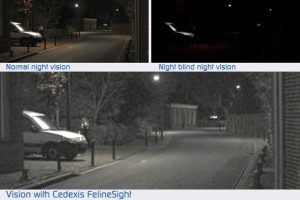

Research
In collaboration with Royal Visio, Cedexis has developed the FelineSight. Videoglasses that can be used as a unique tool for people with Retinitis Pigmentosa (or "night-blindness") eye disease. During the development of the FelineSight the focus was on user comfort, ease of use and high image quality. During the trials the specifications were consistently optimized without losing sight of the cost structure. In the end the combination of quality and durability provided Visio with a highly functioning product.
Retinitis pigmentosa
In the Netherlands alone, over four thousand people suffer from Retinitis Pigmentosa. This is a progressive eye disease, which slowly reduces the field of vision. The disease is accompanied by night-blindness. People suffering from the condition between the ages of fifteen and forty can manage during the day. But in the winter months, when it's dark early, they see almost nothing.
Solution
The FelineSight removes this limitation by using high quality LCD screens combined with a highly light-sensitive camera. This creates a significantly better view. More than enough visibility is created to be able to function normally under reduced lighting conditions.
Testing of night vision glasses
In fourteen rehabilitation centers, thirty people tried out three different visibility improving tools, a flashlight, a headlamp and the night vision glasses. These tools were tested for a period of a month. The rehabilitation center provided support to collect information about the most suitable tool for each individual.
The rehabilitation program consisted of: an intake, visual function research, 4 weeks of mobility training in the dark, reduction of a number of questionnaires and an advisory interview. Countrywide, 60 clients have shown interest for participation in the course of the term, of which 30 night-blind patients have completed this course. In addition to the supervised training, they have practiced 3 weeks in their own environment with the selected tools.
Out of the 30 customers, 12 chose the night vision glasses as the optimal tool, 7 for the flashlight, 4 for the main lamp and 7 for no tool. Because the various tools could be extensively tried in practice, a focused choice was made possible. With the preferred tool, all customers achieved improved mobility and rarely bumped into things. Based on the project results, the rehabilitation protocol has been improved. This resulting protocol Night Mobility at Night Blindness will be a permanent part of the care offer of the national rehabilitation institutions for blind and sight-seeing people. A new training round will start each winter period.
